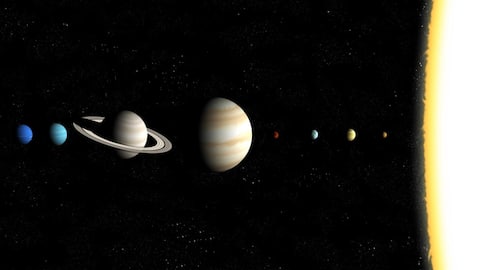Spectacular planetary alignment to light up January 2025 sky
What's the story
In January 2025, six planets—Venus, Mars, Jupiter, Saturn, Neptune, and Uranus—will line up in the night sky in a rare planetary alignment. This happens when planets gather on the same side of the Sun, appearing almost in a line from Earth. This beautiful sight will be visible without a telescope for about four weeks, starting just before January 21. It's a must-see event for anyone who loves stargazing.
Observation guide
Viewing details for the upcoming planetary parade
Four of the six planets - Mars, Venus, Jupiter, and Saturn - will be visible to the naked eye. However, spotting Uranus and Neptune will require a telescope or high-powered binoculars, as these distant planets are too faint to be seen unaided. The ideal time to watch this celestial alignment is just after sunset and will be more difficult to see while the sun is still on the horizon.
Seven-planet parade
Mercury joins the lineup for a brief period
For a brief period, the planetary parade will include seven planets as Mercury joins the party. However, seeing all seven planets together might be difficult as Saturn, Mercury, and Neptune will be near the Sun at sunset. By early March, the visibility of these three planets will fade as they will be moving closer to the Sun.
Stargazing guide
Best viewing period and locations for planetary parade
The best time to catch this astronomical spectacle is between January 21 and February 21, 2025. The week of January 29 during the new moon presents an ideal opportunity for stargazers. This celestial event can be witnessed from multiple locations such as the US, Mexico, Canada, and India. For the best view, find a wide, open area like a field or shoreline. Avoid mountainous areas, forests, or cities, as they may obstruct the horizon.
Previous event
Parade of planets on August 28
In August 2024, a stunning planetary parade took place. Saturn and Neptune first appeared in the evening sky on August 28, with Neptune visible only through a telescope. Uranus and Jupiter joined the show around midnight, followed by Mars close to Jupiter. By early morning, a crescent Moon and Mercury completed the lineup, making for an unforgettable sight in the night sky.
